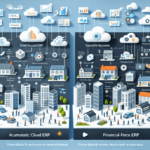Odoo ERP vs FinancialForce ERP
Enterprise Resource Planning (ERP) systems have become indispensable tools for businesses aiming to streamline operations, manage resources efficiently, and enhance overall productivity. Among the myriad of ERP solutions available, Odoo and FinancialForce stand out as two of the most prominent options. This comprehensive comparison delves into their features, usability, costs, integration capabilities, customization options, industry-specific solutions, user feedback, implementation processes, and support services to help you make an informed decision.
Overview of ERP Systems
ERP systems integrate various business functions into a unified platform, facilitating seamless information flow across departments such as finance, human resources, inventory, and supply chain management. By consolidating data, ERP systems enable real-time analytics, enhance decision-making, and boost operational efficiency.
According to a Gartner report, the global ERP software market is projected to reach $89 billion by 2023, highlighting the growing reliance on these systems in the business landscape.
Introduction to Odoo ERP
Odoo is an open-source ERP platform renowned for its modularity and flexibility. It offers a comprehensive suite of applications that cover a wide range of business needs, including:
- Customer Relationship Management (CRM)
- Sales
- Project Management
- Accounting
- Manufacturing
- Inventory
- E-commerce
Odoo's modular structure allows businesses to select and integrate only the necessary modules, ensuring a tailored solution that can evolve with the organization's growth. Additionally, Odoo provides a Community Edition that is free, making it an attractive option for small to medium-sized enterprises (SMEs).
Key Features of Odoo ERP
- User-Friendly Interface: Odoo's intuitive design ensures that users can navigate the system with ease, reducing the learning curve.
- Mobile Accessibility: With its mobile app, Odoo enables users to access critical information and perform tasks on the go.
- Customization: Being open-source, Odoo allows extensive customization to meet specific business requirements.
Introduction to FinancialForce ERP
FinancialForce is a cloud-based ERP solution that emphasizes robust financial management. Built on the Salesforce platform, it offers seamless integration with Salesforce CRM, making it an ideal choice for businesses already utilizing Salesforce products.
FinancialForce covers essential financial operations, including:
- Accounting
- Billing
- Revenue Recognition
- Expense Management
In addition to financial management, it includes modules for human resources, inventory, supply chain, and professional services automation, catering to a wide range of business needs.
Key Features of FinancialForce ERP
- Real-Time Financial Insights: FinancialForce provides up-to-date financial data and comprehensive reporting tools for informed decision-making.
- Customizable Dashboards: Users can create personalized dashboards to monitor key performance indicators (KPIs) effectively.
- Seamless Salesforce Integration: Enhances functionality for businesses already relying on Salesforce for CRM.
Comparative Analysis: Odoo vs FinancialForce
Feature Comparison
Both Odoo and FinancialForce offer a wide range of features, but their focus areas differ:
- Odoo: Offers a broad spectrum of modules covering various business functions beyond finance, such as sales, marketing, and inventory management.
- FinancialForce: Primarily concentrated on financial management with deep integration into Salesforce, making it highly specialized for finance-centric operations.
Ease of Use
Odoo is praised for its user-friendly and intuitive interface, which facilitates easy navigation and reduces the training time required for employees. The drag-and-drop functionality allows businesses to customize workflows without needing extensive technical expertise.
FinancialForce, while powerful, has a steeper learning curve. Its advanced financial features are geared towards finance professionals, requiring users to have a solid understanding of financial management principles.
Cost Comparison
Cost structures differ significantly between the two systems:
- Odoo: Offers a free Community Edition with basic features. The Enterprise Edition's cost varies based on the number of users and selected modules, providing scalability for growing businesses.
- FinancialForce: Utilizes a subscription-based pricing model, which can be more costly for larger teams or organizations with extensive resource requirements.
Businesses with limited budgets may find Odoo's Community Edition more appealing, while larger enterprises with complex financial needs might prefer FinancialForce despite the higher cost.
Integration Capabilities
Integration is a crucial aspect of ERP systems:
- Odoo: Features a robust integration framework that allows seamless connection with various third-party applications, enhancing its versatility across different business functions.
- FinancialForce: Excels in integration with Salesforce, making it an excellent choice for businesses embedded within the Salesforce ecosystem.
Customization Options
Customization plays a vital role in meeting specific business needs:
- Odoo: As an open-source platform, Odoo offers extensive customization capabilities. Businesses can modify existing modules or develop new ones to fit their unique processes.
- FinancialForce: While offering some customization, FinancialForce is more limited due to its proprietary nature, focusing primarily on financial functionalities.
Industry-Specific Solutions
Both ERP systems cater to specific industries:
- Odoo: Provides tailored solutions for industries such as education, healthcare, manufacturing, construction, and hospitality, ensuring that sector-specific needs are met.
- FinancialForce: Targets service-based industries, including professional services, consulting, and non-profit organizations, offering tools that align with their operational requirements.
User Reviews and Ratings
According to G2 Crowd, Odoo and FinancialForce both receive positive feedback:
- Odoo: Users appreciate its flexibility, comprehensive feature set, and cost-effectiveness. However, some have reported challenges with implementation and support.
- FinancialForce: Praised for its robust financial management capabilities and seamless Salesforce integration. Some users have noted a steeper learning curve and higher costs as potential drawbacks.
Implementation Process
The implementation process for each ERP system varies:
- Odoo: Offers a self-hosted Community Edition that businesses can install independently. The Enterprise Edition typically requires assistance from certified Odoo partners, ensuring a smoother deployment process with expert guidance.
- FinancialForce: Provides tailored implementation services, including comprehensive training and ongoing support, ensuring that businesses can effectively integrate the system into their operations.
Support and Maintenance
Support services are critical for the sustained success of an ERP system:
- Odoo: The Community Edition relies on community support, while the Enterprise Edition offers professional support packages, including regular updates and dedicated customer service.
- FinancialForce: Utilizes a ticketing system for customer support and offers various support packages. Additional training and advanced support options are available at an extra cost.
Recommendations for Choosing the Right ERP System
When selecting between Odoo and FinancialForce, businesses should evaluate their specific needs, industry requirements, team size, and budget:
- Choose Odoo if:
- Your business requires a versatile ERP system with a wide range of modules.
- Customization and flexibility are top priorities.
- Budget constraints make the free Community Edition appealing.
- You operate in industries such as manufacturing, education, healthcare, or hospitality.
- Choose FinancialForce if:
- Your primary focus is robust financial management.
- Seamless integration with Salesforce is essential.
- Your organization can accommodate the higher subscription costs.
- You operate within service-based industries like professional services or consulting.
Conclusion
Both Odoo and FinancialForce offer powerful ERP solutions tailored to different business needs. Odoo's modularity and flexibility make it suitable for a wide range of industries and business sizes, especially for those seeking customization and cost-effective solutions. On the other hand, FinancialForce excels in financial management and is ideal for service-based organizations deeply integrated with Salesforce. By carefully assessing your business requirements and considering the features, costs, and support each system offers, you can select the ERP solution that best aligns with your strategic objectives.






















